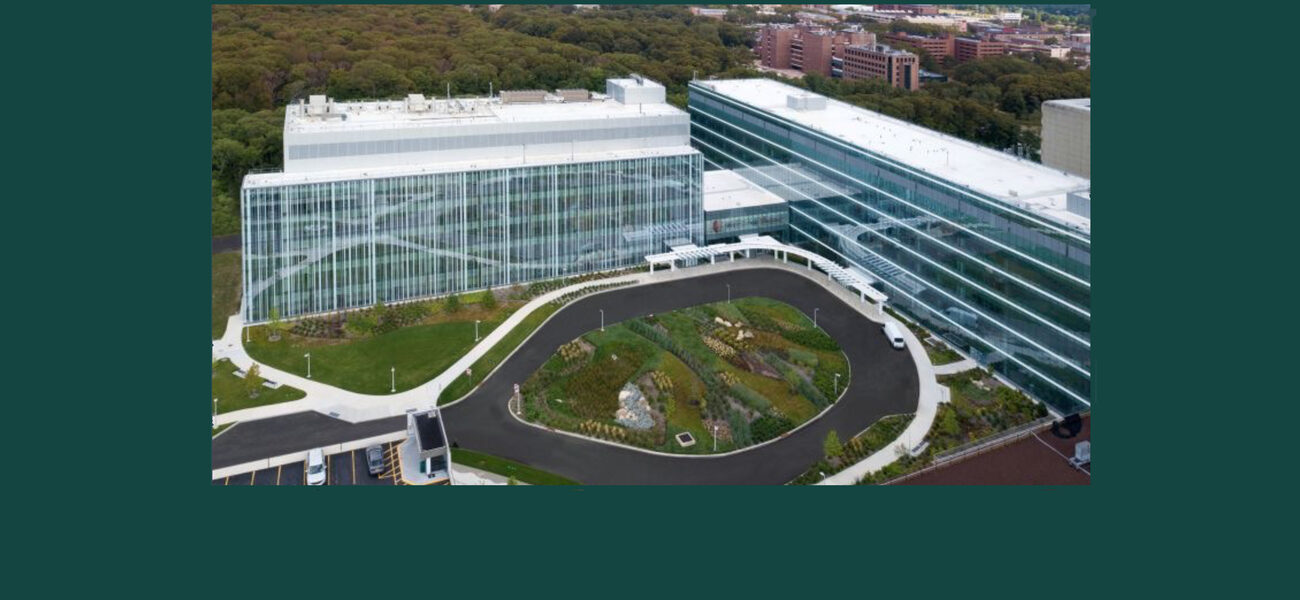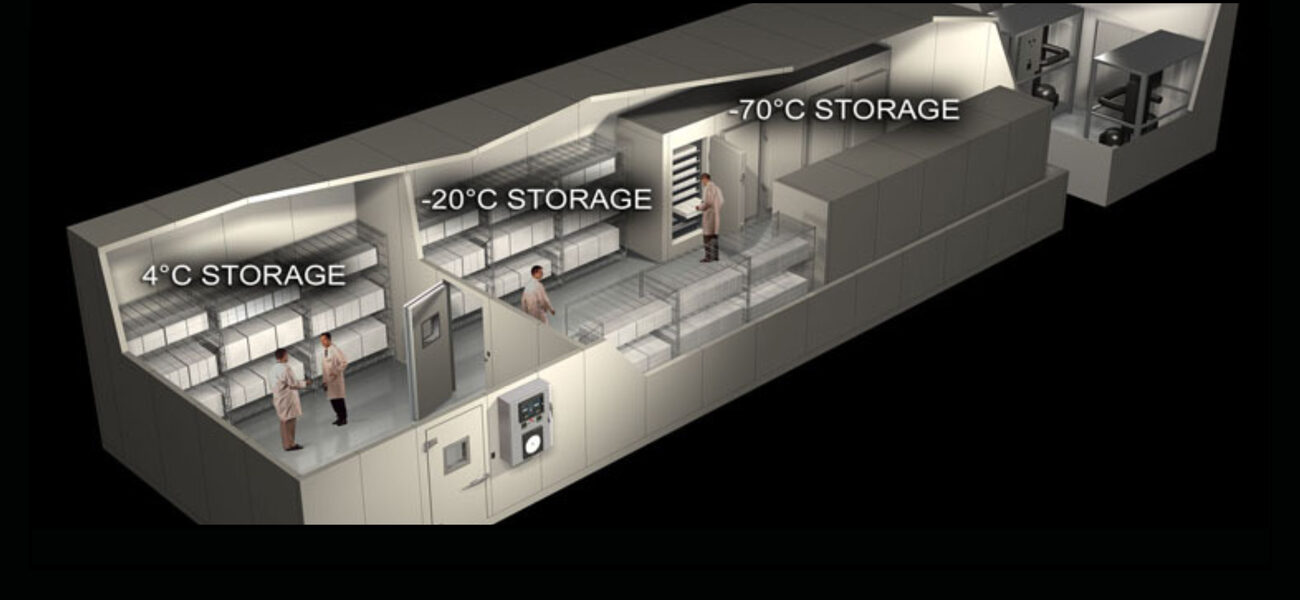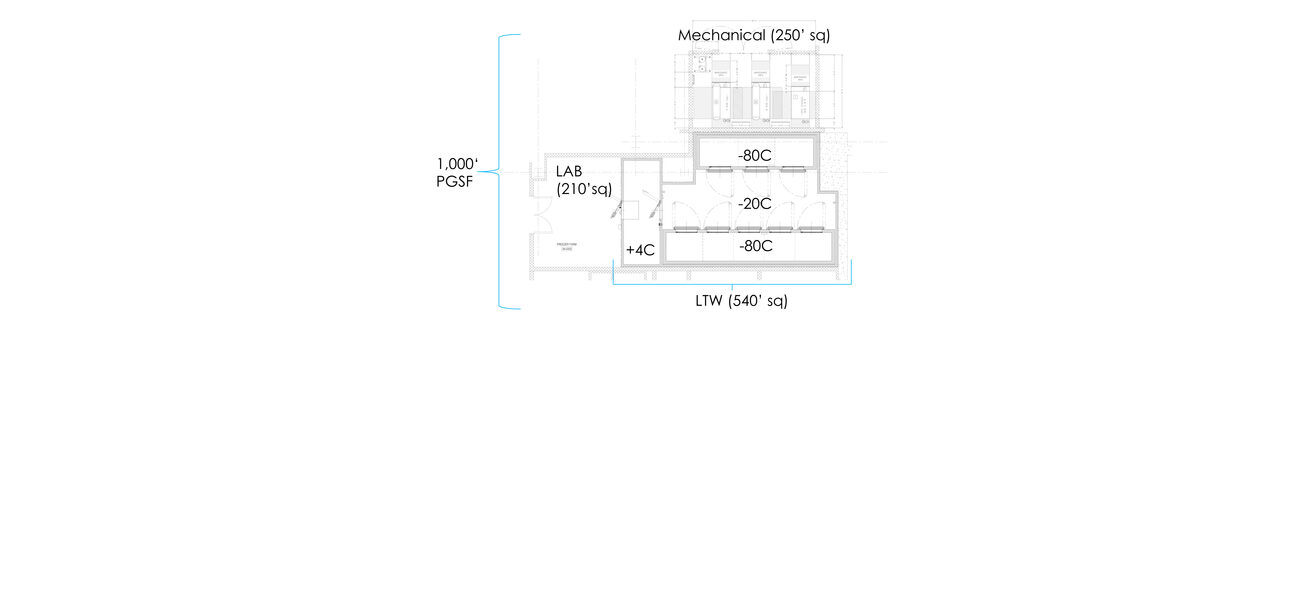Stony Brook University’s Renaissance School of Medicine in Stony Brook, N.Y., has increased its capacity for ultra-low-temperature freezer storage, a need that became critical nationwide in early 2021 when the Pfizer COVID-19 vaccine required that level of storage, limiting which hospitals and pharmacies could offer it. Stony Brook’s new 560,000-sf Medical and Research Translation facility contains a low-temp walk-in (LTW) Freezer Farm suite with eight minus-80-degree-Celsius permanent storage chambers and a minus-20-degree-Celsius storage corridor with a combined capacity of over 1.8 million samples. This is the equivalent storage of 80 traditional point-of-use (POU) stand-alone freezer units.
The freezer farm, the newest core facility at the university, aims to provide safe, reliable, cost-effective, efficient storage for samples requiring ultra-low temperatures. It has helped the school to reduce the overall carbon footprint of the research program, while also supporting 75,000 sf of new wet bench research, primarily in cancer and cancer biology, says Glen Itzkowitz, MA, MBA, associate dean of Facilities and Operations for the School of Medicine. He adds that the new freezer farm has also reduced campus emergency power demand and led to overall energy cost savings.
Stony Brook’s Freezer Farm contains primarily archival research studies and currently stores all specimens related to the Long Island cancer project, a long-term study with an extensive set of both prostate and breast cancer samples, and the World Trade Center archival study of first responders and tradesmen who experienced health issues following their work at Ground Zero. Both of these prominent studies require that all research samples be archived in perpetuity within the new Freezer Farm.
“We are also in talks with the Department of Anesthesiology to store plasmapheresis samples related to COVID-19 in the minus-20 C corridor of the freezer farm,” says Itzkowitz. “In addition, many of Stony Brook’s department chairs are working with our facilities team to decide which of their research samples should be relocated to the new Freezer Farm.” Stony Brook’s School of Psychiatry has already moved 100 percent of their research samples there from various locations throughout the medical campus.
Embracing the Culture Change
Prior to the Freezer Farm, Stony Brook’s researchers were accustomed to storing samples in their own spaces, so moving into the centralized Freezer Farm was a culture shift. “Researchers need to be able to trust that the Freezer Farm will provide the same reliable, safe environment they are used to overseeing for themselves in traditional POU units,” says Itzkowitz. “Although it is a culture shift, it is being widely embraced by our department chairs and researchers, especially when they realize the benefits related to efficiency, cost savings, and sample safeguarding.”
There are many benefits to the Freezer Farm model:
- Cost savings due to lower energy demand and life cycle costs – The suite has demonstrated a 75 percent reduction in total energy consumption while still delivering maximum capacity, multi-temperature storage flexibility, and product protection. Annually, the LTW freezer suite conserves 100,000 kWh of energy and pounds of CO2 emitted.
- Increased sample safety – The LTW freezer has precise temperature monitoring, dual compressors, lead-lag compressor operation, video monitoring, strict access controls, and a time-controlled, man-down alarm system that initiates emergency protocols after only 10 minutes.
- Reduction of overall carbon footprint of research program – The LTW freezer suite has a significantly lower chamber count, resulting in a 33 percent reduction in building space when compared to an equivalent group of POU freezers. Ultimately, this allows researchers throughout the university to convert their previous storage space into functional research, teaching, or administrative space.
“Researchers moving samples into the new Freezer Farm also have the benefit of knowing that we now have a dedicated archivist on staff overseeing the Freezer Farm, which is a new position for the medical center,” says Itzkowitz. The suite is accredited by the International Society of Biological and Environmental Repositories and is ideal for a variety of biopharma and biorepository applications, since it offers flexibility of product storage containers, including bottles, plates, small vials, bulk drums, and canisters.
Reduced Cost of Operation
One of the most significant cost-saving features of the LTW suite is the elimination of more than 18 tons of building air conditioning BTUs. Itkowitz explains that since the LTW suite has its own cooling system, it does not require additional air conditioning to keep the room’s environment cooled, in contrast to POUs, which cast off both heat and white noise, increasing the room’s overall thermal loading. Itkowitz explains that the Freezer Farm is the equivalent of 80 separate minus-80-degree C POU units which cost approximately $1 million to purchase, fully equipment with liquid nitrogen backups and E-Powered circuits with cellular alarms. The Freezer Farm will offer equivalent storage space at only $930,000, a savings of $70,000 up front.
Researchers are charged $26 a month per rack. Each rack equals 1 cubic foot, and provides space for storage of 5-by-5-by-2-inch sample boxes with 81 slot grids within the rack. The Freezer Farm also offers storage options for 15-ml and 50-ml conical tubes.
Enhanced Security
“We recognize that we are safeguarding irreplaceable studies in the Freezer Farm and that some of our researchers have spent their entire careers collecting these samples,” says Itzkowitz. “This is why we even have a backup plan for our emergency system related to temperature control and follow strict access monitoring to the Freezer Farm.”
All refrigeration circuits for the Freezer Farm are on emergency priority-one power demand, the same level adhered to within healthcare systems. If the Freezer Farm were to also lose emergency power, there is a remote-filling valve located outside of the farm’s loading dock that allows for liquid nitrogen (LN2) to be pumped into the farm to ensure that specimens are kept cold.
In addition, the Freezer Farm has strict access-control requirements, including video surveillance and a time-controlled access before man-down alarms start to alert, and provides ample integrity via Freezerworks software. Smart Locks, a digitally-encrypted padlock system, is used to ensure hard security measures inside the farm.
Despite the many advantages to storing archival samples in the new Freezer Farm, Itzkowitz concedes that it will still be necessary for Stony Brook medicine to continue to maintain some POUs throughout the facility, especially for studies that require daily access to specimens; four POU freezers will be dedicated to supporting transfer of samples in and out of the Freezer Farm, one of which is centrally located outside of the Farm for after-hours specimen drop-off.
“For any program that has long-term archival research studies, introducing an ultra-low-temp storage model similar to our Freezer Farm is very worthwhile to consider,” says Itzkowitz. “If your stakeholders are willing to embrace change, this model can become a high-value asset to any research institution.”
By Amy Cammell


